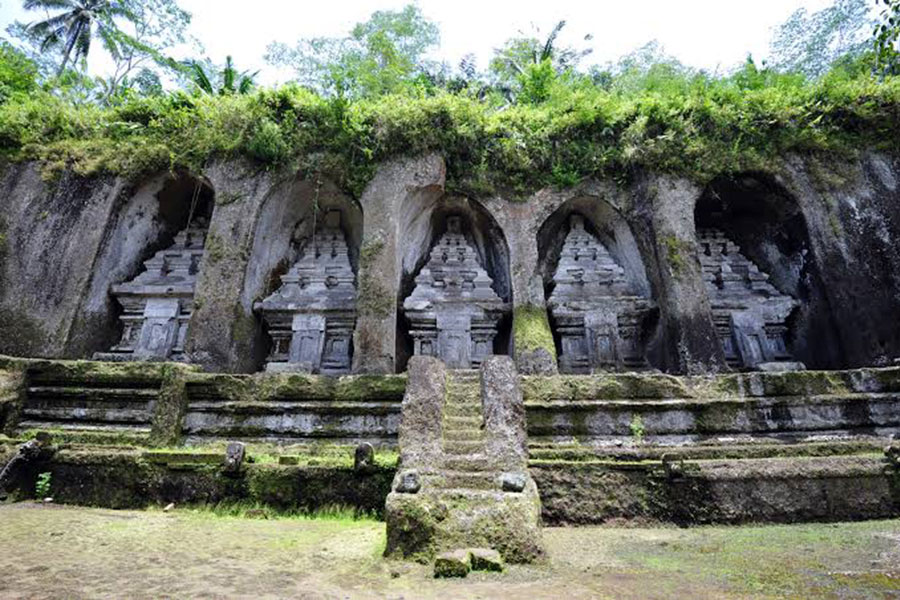GUNUNG KAWI TEMPLE
BALI GUNUNG KAWI TEMPLE IS ANCIENT ROYAL TOMBS IN POET OF MOUNTAIN WITH COLLECTION OF HISTORICAL CANDI

Gunung Kawi Temple in Tampaksiring, or Bali’s Valley of the Kings, is beautifully nestled in a river valley surrounded by rice fields and forests. It has been one of our favorite Gianyar places of interest as travel destinations for years. Gunung Kawi Temple is a collection of ten temples created to create an impressive temple landscape and was planned as a residence for ancient kings. These temples are carved into the valley walls on both sides of the Pekerisan River. Gunung Kawi Temple has an interesting history, with inscriptions on each temple dating its construction to the 11th century. It is believed that each temple served as a tribute to royalty who were considered sacred, especially since their shape resembles funeral towers or temples often found in Central Java.
If you visit Gunung Kawi Temple, here’s what you need to know :
- Gunung Kawi Temple Location
- What is Gunung Kawi Temple
- Ancient Royal Tombs at Gunung Kawi Temple
- Mythical Story About Gunung Kawi Temple
- History Gunung Kawi Temple
- Path to Gunung Kawi Temple
- Geography Gunung Kawi Temple
- Facilities of Gunung Kawi Temple
Gunung Kawi Temple Location
The location of Gunung Kawi Temple is in Tampaksiring Village, Gianyar Regency, Bali, and is quite easy to find as it is located on a strategic main road. The temple is adjacent to Tampak Siring Village, about 5 kilometers from the famous Tirta Empul Temple. The distance is about 35 kilometers from Denpasar, 50 kilometers from Kuta, and 68 kilometers from Nusa Dua. The drive from Kuta takes about 90 minutes, with clear directions at every crossroads to Gunung Kawi Temple. The location of Gunung Kawi Temple is connected to other tourist routes such as Goa Gajah Temple, Pusering Jagat Temple, and Tirta Empul Temple. If you want to visit without confusion, you can contact Bali Exotic Tour. We will take you to enjoy the uniqueness of Gunung Kawi Temple with affordable transportation and accompanied by experienced drivers, which makes your trip more interesting.
What is Gunung Kawi Temple
Gunung Kawi Temple is a historical site that has been discovered and preserved until today because it has many ancient relics that contain important historical values about the lives of Balinese people in ancient times. This place is thought to be the burial site of an ancient royal family, with buildings and temples carved into high stone cliffs, adding to the beauty of this tourist destination. The shape of the temple carved into the stone has similarities with temples in Java. Apart from Gunung Kawi Temple, the area also has many ancient sites, stone carvings, and stone-carved structures, especially along the slopes of the Pakerisan River. The village is rich in ancient relics in the form of stone carvings, and even the oldest historical facts about Buddhism are found around the village. In recognition of its rich history, a museum has been built in front of Pejeng village, near Kebo Edan temple. Pejeng village itself is a place rich in historical heritage, with several heritage temples such as Pusering Jagat Temple, Rejuna Metapa Temple, Kebo Edan Temple, Samuan Tiga Temple, Bedugul Kana Temple, and many other small temples that hold ancient stone carvings. Pejeng can be considered a living and authentic history museum.
Ancient Royal Tombs at Gunung Kawi Temple
Gunung Kawi Temple is an ancient royal tomb complex located on the banks of the Pakerisan River, within a ravine overlooking terraced rice fields. The sacred Pakerisan River flows through the middle of Gunung Kawi, dividing the site into two separate sections connected by a bridge. It is believed that the Pakerisan’s holy waters bless Gunung Kawi, while its natural beauty creates a relaxing and peaceful atmosphere. On the east side of the river are the five main temples in the complex, while across the bridge, there are four temples on the west side. The last temple at the southern end is often referred to as the ‘tenth tomb’. The location of the tenth tomb can be accessed through a small field about a kilometer away, where there are relief carvings on the solid stone of a unique tomb shape. Although the origin of these temples is not entirely clear, evidence suggests that the first five temples were built in honor of King Anak Wungsu, who ruled over central and eastern Bali from around 1050 AD to around 1080 AD. It is possible that one temple was built for the king, while the other four were made for the wives who followed the tradition of ceremonial suicide after his death.
Mythical Story About Gunung Kawi Temple
There are many legends associated with the Gunung Kawi Temple site, which has become an attraction and mystery for the local community. One such story is about a giant named Kebo Iwa, who is said to have carved all the ancient tombs in one night with his huge nails. In addition, there is also an interesting historical story associated with Gunung Kawi Temple. It is said that there are three temples known as Gunung Kawi in Bali, namely Gunung Kawi Temple in Sebatu village, Gunung Kawi Temple in Keliki village, and Gunung Kawi Temple in Babitra village. Around these small temples, there are meditation caves that indicate that this place has a pre-Hindu history, where monks and pilgrims gathered to meditate. Kebo Iwa himself is a legendary figure in Bali who has extraordinary powers. It is said that his magic made the kings of Bali very afraid of him, and with his power, he was able to protect Bali from attacks by outside kingdoms who wanted to conquer the island. These stories are part of Bali’s cultural and historical heritage, giving Gunung Kawi Temple a mystical and unique feel. Gunung Kawi Temple, besides being a silent witness to the ancient kingdom, also depicts a special burial system for the royal family.
History Gunung Kawi Temple
Gunung Kawi Temple, if we look at its name, may have an interesting meaning. “Gunung” can be interpreted as a natural height (Mountain) and “Kawi” as a word related to culture (Pujangga). Thus, Gunung Kawi can be interpreted as a mountain of poets. The river that forms the ravine and the slopes that are cut to build the temple is the Pakerisan River, while the word “keris” refers to a traditional Balinese weapon. However, the true meaning of this name remains a mystery to this day. Nonetheless, we can draw conclusions from historical relics, such as inscriptions that talk about the past as well as stories that developed in the local community, to try to understand the true essence of Gunung Kawi Temple.
Who was the king monumented at Gunung Kawi Temple remains an unsolved mystery to this day. Based on the style of writing on the inscription called “rectangular Kadiri writing style”, the influence of the Kadiri kingdom on Bali only reached its peak around 1227 AD under the reign of King Kertanegara. Meanwhile, stone carvings on Mount Panulisan in the same style show dates of 1011 AD, 1074 AD, and 1077 AD. These cover the reign of King Udayana Warmadewa and his consort Mahendradatta between 989 AD and 1001 AD. In their charters, it is mentioned that King Udayana was deified at “Banyu Wka” and Queen Mahendradatta was deified at Buruan, which has been identified. However, “Banyu Wka” remains unidentified to this day. Archaeologists suspect that “Banyu Wka” may refer to Gunung Kawi, as “Banyu” means water, and “Wka” means clear or clean, indicating a river with very clear water. However, a recently renovated ancient monument is Mangening Temple, which also refers to the name “ening” or clear. This temple complex is relatively small, consisting of only one stone temple with a small zone, in contrast to the larger monument to the queen at Buruan. From this, it can be understood that the king buried at Gunung Kawi may not have needed a large complex to memorialize him, as is evident from the more modest size of the temple complex.
Who is monumented at Gunung Kawi? Some archaeologists believe that it is Udayana’s son, either King Marakata Pangkajasthana or Anak Wungsu. Marakata’s reign does not have many records, while Anak Wungsu is known for his many published inscriptions, showing his activity in documenting his reign, similar to his father, King Udayana. With a reign from 1049 AD to 1077 AD, this suggests that the state of society was good at the time and that Anak Wungsu was likely respected by his people. As is customary in many places in Indonesia, it is common to build temples or statues in honor of a king who has improved the condition of society. In this context, I tend to believe that Gunung Kawi was dedicated to commemorating the great name of King Anak Wungsu.
Path to Gunung Kawi Temple
The Gunung Kawi Temple tourist destination offers a unique experience to see ancient historical relics. Upon arrival at the parking lot, the journey continues on foot from the parking area to the temple location. Although the distance is a bit far from the parking lot, when you arrive at the entrance ticket location, you will embark on a journey down more than 100 steps. Although the journey down these stairs can be a little tiring, the views you will see here are very satisfying. During the trip down the stairs, you will be treated to unspoiled natural scenery, including rice fields belonging to local residents. After passing through a small river and crossing a bridge, you will arrive at the historic Gunung Kawi Temple. Here, you will see high stone cliffs carved with temple sculptures similar to those of temples on the island of Java. Enjoy the beauty of Gunung Kawi Temple with the cool air around you. The pleasant atmosphere around this site will make your visit a wonderful and memorable experience.
Geography Gunung Kawi Temple
People today consider this complex to be part of a temple that was built at a later date. Historically, this temple is not related to the worship of Hindu gods as in a normal temple but more to the worship of the king. The complex consists of 5 smaller complexes, with 6 temples included in the complex. Two complexes are on the eastern slope of the river, and 3 complexes are on the western slope of the river. The two complexes that are on opposite sides and separated by the river are considered to be the shrines of the king and his consort or concubine. The complex for the king consists of 3 stone-carved temples, while the complex for the queen consists of 4 stone-carved temples. There are difficulties in understanding why there are only 3 temples for the king. It is likely that the king was accompanied by his two main consorts, and the 4 temples on the other side of the river were made for his other concubines. An inscription at the entrance of the temple for the king records that the king died in Jalu. “Jalu” may refer to a kris or spur, which is a small, sharp knife used in cockfighting.
Facilities of Gunung Kawi Temple
The Gunung Kawi Temple tourist destination in Ubud village offers very complete facilities, making it one of the most frequently visited historical tourist destinations. In this area, there is a large parking area, so you will have no trouble finding a parking space. Around the parking area, there are shops selling drinks and snacks, perfect for those of you who want to quench your thirst and take a short break at the stalls available. In addition, along the road to Gunung Kawi Temple, there are various shops on the left and right of the road that offer various local handicrafts. You can buy some as souvenirs for your family or partner. There is also an entrance ticket counter where you will be given a shawl to wear when entering the temple area. The use of this shawl is a form of respect for the existence and sacredness of the Gunung Kawi Temple site, and the best thing is that this shawl is provided free of charge by the management. So, with complete and comfortable facilities like this, you don’t need to hesitate anymore to visit Gunung Kawi Temple. Your tour experience in Bali will be very pleasant and satisfying.

